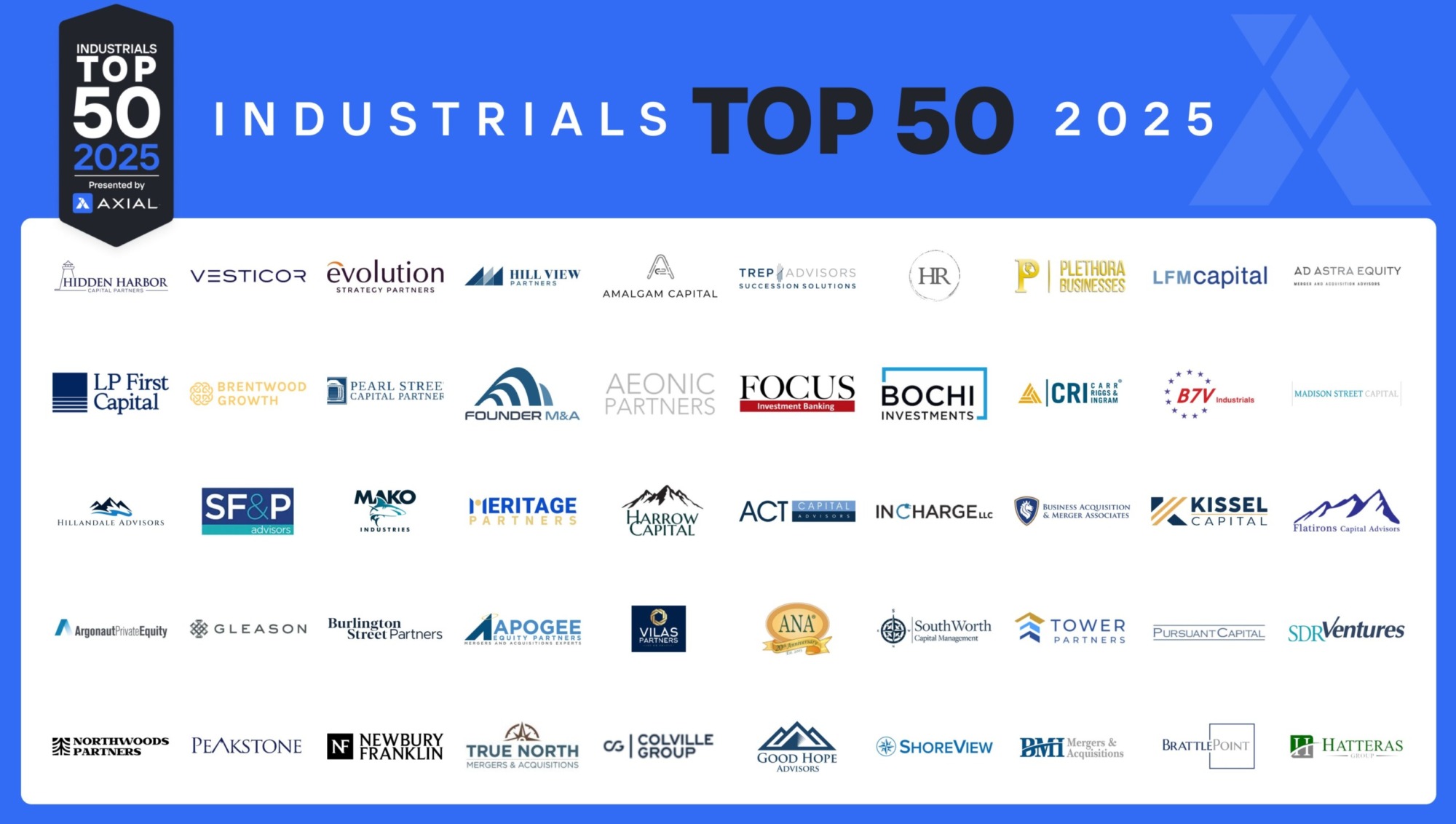
The Top 50 Lower Middle Market Industrials Investors & M&A Advisors [2025]
Industrials remains the most dominant sector in Axial deal flow, representing more than 25% of all deals brought to market…
Any way you look at it, the electric vehicle market is gargantuan. EVs are often made in gigafactories, a term coined by Elon Musk for Tesla (of the $1 trillion market cap). The world’s 20 largest auto companies (already massive) have announced plans to invest $500 billion (huge, even for them) to convert gas-powered product lines to electric. In 2021 alone, global spending on EVs, charging, and related infrastructure was $273 billion, up 77% (stratospheric).
The industry is just entering the on-ramp. Sales of electric and plugin hybrid passenger vehicles will increase from 6 million in 2021 to 27 million in 2030, according to S&P global projections. That would be more than half of all vehicles sold in the world and represent annual revenue of more than $1 trillion.
Even as the titans battle for this immense market, the opportunities for small and midsize businesses are, well, really big.
“There was always buzz about Tesla,” says Michael McGregor, a managing director with Focus Investment Banking. “Now there is more excitement because there are starting to be a lot of really good EVs out there. So everybody is jumping in.”
The transition to electric vehicles will radically change the vast ecosystem of independent companies supporting the auto industry—parts makers, dealers, leasing companies, gas stations, body shops, etc.
Advisors in the middle market are going to be very busy in the coming years, helping these companies raise capital, grow, and negotiate the inevitable consolidation.
They also must navigate frothy but fickle investor sentiment. Last year, public and private investors poured $67 billion into electric transportation (including electric cars, trucks, scooters, airplanes, and the parts that go in them), according to Bloomberg. Valuations fell sharply at the end of 2021, in part because the Biden administration couldn’t get its ambitious EV investment plans through Congress. With gas prices now shooting up because of the sanctions on Russia, interest in EVs is bouncing back.
The geopolitical turmoil compounds the uncertainty about the technology, economics, demand, and business model for EVs, creating a challenge for middle-market companies trying to raise capital.
“When you go to talk to some of these investors, they say, ‘Oh my god, we are seeing so many EV-related companies,” said John Dilatush, a managing director Auctus Capital Partners. “There is a lot of competition for their attention.”
For example, Auctus has been raising money for Tropos Technologies, which makes a small electric utility vehicle that can be used inside factories, on college campuses, for local deliveries, among other applications. The economics of this business is very different from traditional truck companies. Much of the profit comes from specialized modules for various applications that can be installed on the flatbed of the Tropos vehicle.
“Most investors start out pretty skeptical,” Dilatush says. “They are not familiar with this form factor, and they’ve seen some EV companies go public that didn’t turn out to have a fully formed business idea.”
His response is to “fight with math,” walking investors through the Tropos business model. “They see that we have this app-store model that creates revenue and differentiation.”
The challenges are different for middle-market companies that are already established in the gas-powered car market.
“You can see who the winners and losers will be,” McGregor says. “You can diversify into EV stuff, or you can fully commit to the internal combustion engine.” Both strategies are valid, he says. “There is going to be a runway for years for those manufacturers, and they are going to double down and gobble up other folks.”
This choice is especially stark for companies that make auto parts. An electric car isn’t just your dad’s Chevy, just with a different motor and a battery in the trunk. Most of the major systems are different. Brakes, for example, now work in tandem with a generator that uses the energy of the car to recharge the battery. And there’s no need for a muffler or exhaust pipe. A major component of every EV is software, lots of software.
McKinsey estimates that more than half of the money spent on auto parts in 2030 will be for batteries, electric motors, and sensors that aren’t in gas-powered cars.
These changes flow in turn to parts dealers and repair shops. EVs, for example, require less routine service, like oil changes and brake replacements. What they do need tends to be complex and requires the shop to buy expensive equipment. There’s some good news for local parts dealers: EVs wear out their tires much faster than gas-powered cars.
There are myriad new opportunities as well. For example, T Sportsline created a series of add-on products for Tesla cars aimed at the “tuner” market, including wheels, seat covers, and carbon fiber trunk spoilers. As EVs took off, the company sold a controlling stake to Kian Capital to fund its growth. T Sportsline was represented by Focus.
“It’s always been an entrepreneurial space,” McGregor says. “As the old guys age out, new ones enter. They are smart and see where it’s going: EVs and ecommerce.”
Car dealers are in for some rude shocks as well. Service revenue—a primary source of profit—is 40% less with an electric vehicle, McKinsey estimates. EV makers also increasingly fix problems using wireless software upgrades, eliminating another reason that people need to visit the dealer. On the other hand, EVs cost more upfront (but are cheaper to operate), creating more demand for financing, the other big dealer profit center.
No part of the industry will change more than refueling. The entire supply chain from oil well to gas station is irrelevant for EVs. Right now, 90% of EVs are charged at home overnight. Experts expect apartment buildings, office complexes, and shopping centers all to install charging stations in their parking lots, spawning many companies to build, install and maintain the charging equipment.
There will be the electric equivalent of gas stations for people who need to top up on long trips. But these require expensive fast-charging equipment and a physical layout very different from the corner Exxon station. By 2030, electric vehicle charging will be a $15 billion business, Morgan Stanley predicts. For now, however, the companies that are trying to build chains of charging stations– ChargePoint Holdings, Blink Charging and Beam Global—are finding revenue scarce and profits nonexistent.
That’s the challenge in every area of the burgeoning EV world. Everyone is convinced it’s going to be big, huge, colossal even. But they aren’t sure exactly how or when.
“We’ll need some time to separate the good from the bad and the crazy from the rational,” Dilatush says. “That’s just the stage the market is in right now.”
